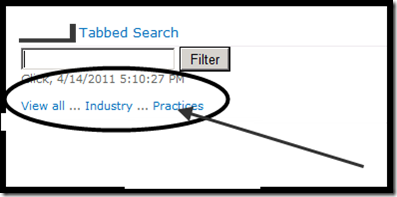Sto facendo un po' di roba XSL ultimamente e pensato che avrebbe messo insieme un campione per il mio riferimento futuro e che può essere di valore per tutti noi facendo una vita in internets XSLT-ers.
Si consideri il seguente codice XML:
<Count FdcSearchTabsCollection = "2">
<Contestuale Label = "Industry" SortOrder = "00" Label = "Industrie" SearchConstraints = "contenttype:Industria" TabID = "831b2a74-98c4-4453-8061-86e2fdb22c63" />
<Contestuale Label = "pratiche" SortOrder = "01" Label = "Pratiche" SearchConstraints = "contenttype:PracticeGroups" TabID = "678e206b-6996-421f-9765-b0558fe1a9c0" />
</FdcSearchTabsCollection>
Il seguente frammento XSL genererà un elenco ordinato di schede href:
<xsl:partita modello = "FdcSearchTabsCollection" XML:Space = "preserve">
<!– Il tutto"" scheda –>
<href = "javascript:ViewTab('Tutti')">Visualizza tutte</un>
<!– Ogni scheda individuale –>
<!– Scorrere tutte le schede e visualizzare la corretta link. –>
<xsl:for each = seleziona "Contestuale">
<xsl:sorta select="@SortOrder"/>…
<href = "javascript:ViewTab(‘{@ TabID}’)"><xsl:valore di select="@Label"/></un>
</xsl:for each><br />
</xsl:modello>
Ecco quello che sembra in SharePoint:
</fine>
Seguimi su Twitter a http://www.twitter.com/pagalvin

Ehi, Paul. Interessante che il XML non è valido, come ogni elemento di SearchTab ha due attributi Label. Ti prego, dimmi che SharePoint non genera che!
M.